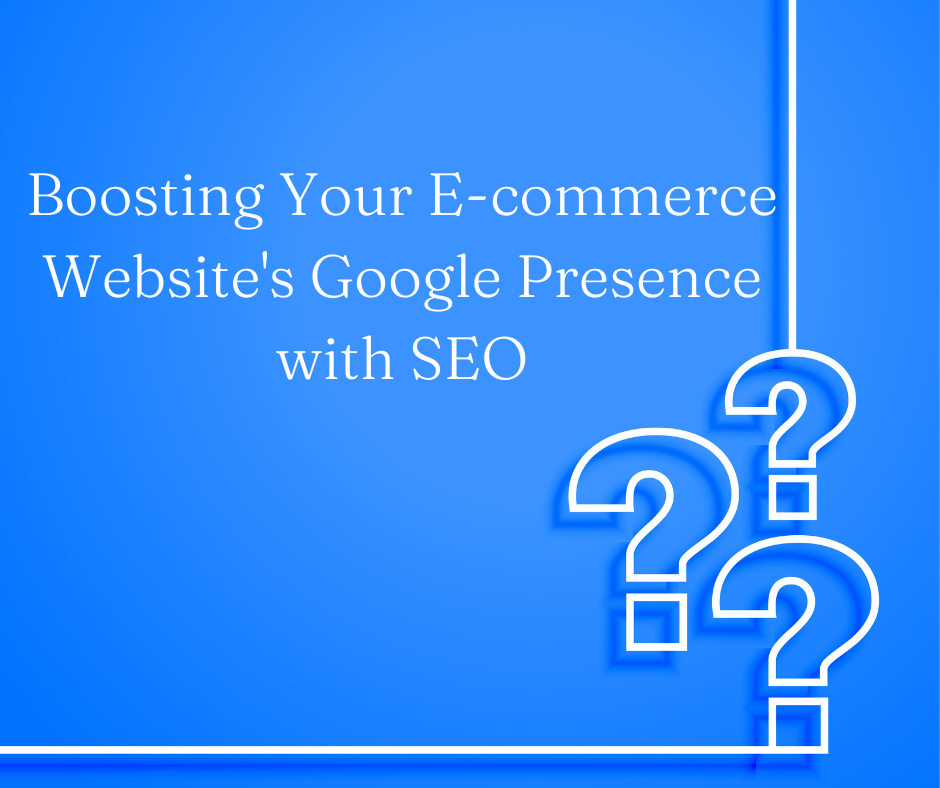In today’s competitive digital world, having a solid online presence is vital for e-commerce success. One of the most effective ways to achieve this is through Search Engine Optimization (SEO). By implementing a well-rounded SEO strategy, you can increase your e-commerce website’s visibility on Google and attract more organic traffic.

In this blog post, we’ll delve into ten key points that can help you optimize your e-commerce website’s Google presence.
1: Organic Search Traffic
Setting specific targets for increasing organic traffic is the cornerstone of your SEO strategy. Establish measurable goals on a monthly or quarterly basis to monitor your progress and adjust your tactics as needed.
2: Keyword Rankings
Keywords play a pivotal role in SEO. Aim to boost your website’s rankings for key search terms. The ultimate goal is to land on the first page of search results or secure specific positions.
3: Click-Through Rate (CTR)
Optimizing title tags, meta descriptions, and rich snippets can significantly impact your CTR—set goals for improving these elements to entice more clicks from search engine users.
4: Organic Backlinks
The Backlinks are like votes of confidence from other websites. Establish targets for acquiring new backlinks within a defined timeframe. High-quality backlinks can enhance your site’s authority and trustworthiness.
5: Domain Authority (DA) or Page Authority (PA)
Higher DA and PA scores indicate improved site authority. Aim to enhance these scores, as they can positively influence your rankings and overall visibility.
6: Indexed Pages
Ensure that search engines index all essential pages of your website. Keep track of the number of indexed pages and set a target percentage for site coverage.
7: Mobile Optimization
Given the increasing use of mobile devices, mobile optimization is crucial. Monitor mobile traffic, page load times, and mobile usability. Set objectives to improve mobile performance, ensuring a seamless user experience.
8: Local SEO Metrics
If your e-commerce business has a local presence, focus on local SEO metrics. Monitor local search rankings, Google My Business (GMB) impressions, and user reviews. Positive local SEO can drive more foot traffic to your physical stores or increase online sales.
9: Content Metrics
Content is the heart of your e-commerce website. Track the performance of your website content by monitoring metrics such as the number of blog posts published and engagement indicators like comments, likes, and shares. Quality content can establish you as an industry authority and attract more organic traffic.
10: E-commerce Metrics
Finally, set specific Key Performance Indicators (KPIs) for your products. Monitor product page rankings, organic sales, and revenue generated through organic search traffic. These metrics directly impact your bottom line and should align with your business objectives.

In conclusion, improving your e-commerce website’s Google presence via SEO involves a multifaceted approach. Setting clear goals for organic traffic, keyword rankings, CTR, backlinks, authority scores, indexed pages, mobile optimization, local SEO, content, and e-commerce metrics will provide a comprehensive framework for enhancing your online visibility and driving more organic traffic to your website. Monitor your progress, adapt to algorithm changes, and consistently work towards your SEO objectives to maintain a strong Google presence.

